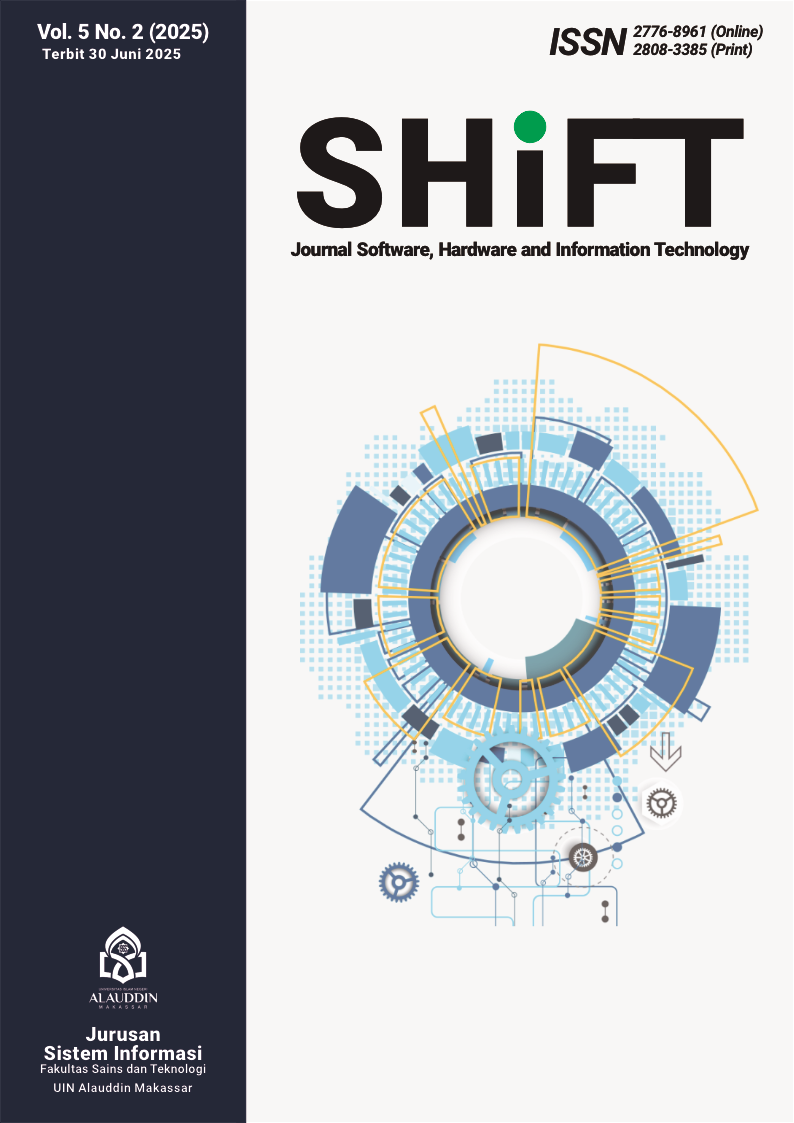Perancangan Sistem Mobile Reporting Berbasis Android untuk Pelaporan Preventive dan Corrective Maintenance di PT Telkom Indonesia Divisi Regional V
Main Article Content
Abstract
Preventive, corrective, and maintenance activities are crucial tasks in the NE & OM Division of PT Telkom Indonesia Regional V. Despite the availability of a reporting system through Telegram bot and PACMAN-NEO web, the recording and reporting process is still considered less than optimal and is often complained about at the regional level. The main problems include data inaccuracy, lack of innovation and credibility, and visualization that has not met user expectations. This research aims to overcome the problems of slow, inaccurate, and less real-time reporting, as well as improve the features of navigation, verification, and monitoring of technician activities. The development method used is the System Development Life Cycle (SDLC) Waterfall model. The application was developed using Dart and Flutter as front-end frameworks, PHP and Laravel for API management, and PostgreSQL as the database. The black box test results show that all features function according to user needs. This application has been tested by 3 regional managers, 4 witel managers, 1 regional admin, and 10 technicians. User evaluation showed results of 75% for usability, 63% for ease of use, and 78% for user satisfaction. These results indicate that the developed application is feasible to use as a replacement for the previous Telegram-based PACMAN-NEO system.
Downloads
Article Details

This work is licensed under a Creative Commons Attribution-NonCommercial-ShareAlike 4.0 International License.
References
G. Michalczuk and U. Konarzewska, “Standardization of corporate social responsibility reporting using the GRI framework,” Optimum. Econ. Stud., no. 1 (99, pp. 74–88, 2020.
T. P. Nagarhalli, V. Vaze, and N. K. Rana, “A review of current trends in the development of chatbot systems,” in 2020 6th International conference on advanced computing and communication systems (ICACCS), 2020, pp. 706–710.
K. Velmurugan, S. Saravanasankar, and S. Bathrinath, “Smart maintenance management approach: Critical review of present practices and future trends in SMEs 4.0,” Mater. Today Proc., vol. 62, pp. 2988–2995, 2022.
S. M. Suhaili, N. Salim, and M. N. Jambli, “Service chatbots: A systematic review,” Expert Syst. Appl., vol. 184, p. 115461, 2021.
R. D. Zota, I. A. Cîmpeanu, D. A. Dragomir, and M. A. Lungu, “Practical Approach for Smart and Circular Cities: Chatbots Used in Waste Recycling,” Appl. Sci., vol. 14, no. 7, p. 3060, 2024.
A. S. Handayani, N. Hopipah, and M. Fadhli, “The implementation of mobile technology in the process of reporting disasters and events,” IJCCS (Indonesian J. Comput. Cybern. Syst., vol. 17, no. 4, pp. 405–416, 2023.
S. D. Purnamasari and F. Panjaitan, “Pengembangan Aplikasi E-Reporting Kerusakan Lampu Jalan Berbasis Mobile,” Jusikom J. Sist. Komput. Musirawas, vol. 5, no. 1, pp. 59–69, 2020.
R. Ramadhan, W. H. N. Putra, and B. T. Hanggara, “Pengembangan Sistem Informasi Manajemen Pelaporan Gangguan WIFI. ID berbasis Web di PT. Telkom Indonesia Witel Jakarta Timur,” J. Pengemb. Teknol. Inf. dan Ilmu Komput., vol. 4, no. 6, pp. 1732–1739, 2020.
T. Rahim and M. Muhardi, “Sistem Pelaporan Gangguan Jaringan Telkom Dengan Metode Apriori dan Generalized Rule Induction,” in SISITI: Seminar Ilmiah Sistem Informasi dan Teknologi Informasi, 2022, vol. 11, no. 1, pp. 217–224.
N. Nasrum, Z. Zulkarnain, and N. Nurdiansah, “Sistem Pelaporan Gangguan Jaringan Telkom Dengan Metode Apriori dan Generalized Rule Induction,” Dipanegara Komput. Sist. Inf., vol. 16, no. 1, pp. 66–70, 2022.
E. Nurmala, “Analisa Dan Perancangan Sistem Layanan Gangguan Indihome Berbasis Web Pada Pt. Telekomunikasi Indonesia Tbk, Telkom Witel Nusa Tenggara Barat,” Hexagon, vol. 2, no. 2, pp. 23–31, 2021.
H. M. Febrianda and E. Maiyana, “Sistem Aplikasi Mobile Pelaporan Masalah: Layanan Aspirasi Dan Pengaduan Online Rakyat,” J. Inf. Syst. Educ. Dev., vol. 2, no. 3, pp. 14–16, 2024.
Y. Hari and M. K. Putri, “Analysis and Development of Information System for Cyberbullying Tendency on Twitter Social Media Using the Naï ve Bayes Approach,” Int. J. Res. Innov. Soc. Sci., vol. 8, no. 6, pp. 1551–1557, 2024.
Y. Hari, M. E. Yanggah, and A. S. Paramita, “Assessing Novice Voter Resilience on Disinformation During Indonesia Elections 2024 with Naïve Bayes Classifier,” J. Appl. Data Sci., vol. 6, no. 1, pp. 299–310, 2025.
Y. Hari, D. Darmanto, M. Paramitha, and M. E. Yanggah, “Pengembangan Sistem Layanan Minibank untuk Mendukung Badan Layanan Umum Daerah (BLUD) di SMKN Surabaya,” UN PENMAS (Jurnal Pengabdi. Masy. untuk Negeri), vol. 3, no. 1, pp. 8–15, 2023.
I. D. Kusuma, I. G. L. A. O. Cahyadi, and U. L. Yuhana, “Black box testing in the Access by KAI application using boundary value analysis and graph-based testing,” INFOTECH J., vol. 10, no. 1, pp. 122–127, 2024.
M. Sholeh, I. Gisfas, and M. A. Fauzi, “Black Box Testing on ukmbantul. com Page with Boundary Value Analysis and Equivalence Partitioning Methods,” in Journal of Physics: Conference Series, 2021, vol. 1823, no. 1, p. 12029.
